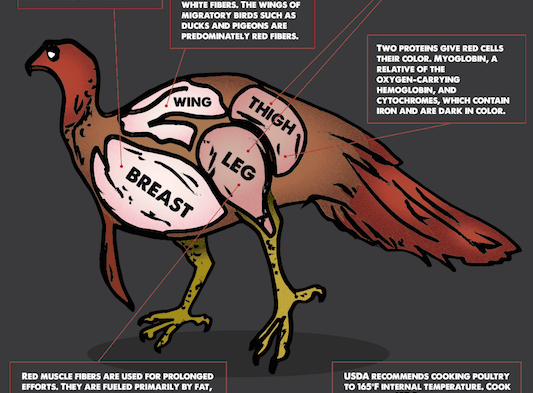Turkey Meat: White vs. Dark
Have you ever stopped to considered why poultry has both white and dark meat, why the two taste different, and why they have to be cooked to different temperatures? Food Scientist Harold McGee says it has everything to do with the different kinds of muscle fibers and the particular kind of work that each is designed for.
Animals move in two basic ways, suddenly and persistently. For example, when startled, a turkey will rapidly explode into the air. The same animal will move more deliberately to support its body weight as it stands and walks. McGee says, “There are two basic kinds of muscle fibers that execute these movements, the white fibers of…breasts, and the red fibers of…legs. The two types differ in many biochemical details, but the most significant difference is the energy supply each uses.”
“White muscle fibers specialize in exerting force rapidly and briefly,” McGee says. “They are fueled by a small store of a carbohydrate called glycogen, which is already in the fibers, and is rapidly converted into energy by enzymes right in the cell fluids.”
These white cells use oxygen to burn glycogen, but if necessary they can generate their energy faster than the blood can deliver oxygen. When they do so, a waste product, lactic acid, accumulates until more oxygen arrives. It’s that accumulation of lactic acid, McGee says, that limits the cells’ endurance. This is why white cells work best in short intermittent bursts with long rest periods in between, during which the lactic acid can be removed and glycogen replaced.
McGee continues, “Red muscle fibers are used for prolonged efforts. They are fueled primarily by fat, whose metabolism absolutely requires oxygen, and obtains both fat (in the form of fatty acids) and oxygen from the blood. This machinery includes two proteins that give red cells their color. Myoglobin, a relative of the oxygen-carrying hemoglobin that makes blood red, receives oxygen from the blood, temporarily stores it, and then passes it to the fat-oxidizing proteins. And among the fat oxidizers are the cytochromes, which like hemoglobin and myoglobin contain iron and are dark in color. The greater the oxygen needs of the fiber, and the more it’s exercised, the more myoglobin and cytochromes it will contain.”
The proportions of the different fibers in the given muscle depend on the inherited genetic design for that muscle and the actual patterns of muscle use. Chickens and turkeys fly only when startled, run occasionally, and mostly stand and walk; so their breast muscles consist predominantly of white fibers, while their leg muscles are on average half white fibers, half red.
As to which type of meat tastes best, we’ll leave that for you to decide.
Download Turkey Infographic, here.
Resources: Harold McGee “On Food and Cooking: The science and lore of the kitchen”


